Stuart Reeves is a professional photographer, a passionate birder, and member of BirdLife Jamaica, based in Kingston. The group’s members have been missing their regular group outings due to the restrictions of the COVID pandemic. However, Jamaicans are still managing to see plenty of wonderful birds! Read Stuart’s delightful story for some inspiration and insider tips on how to attract, observe, and photograph your backyard birds.
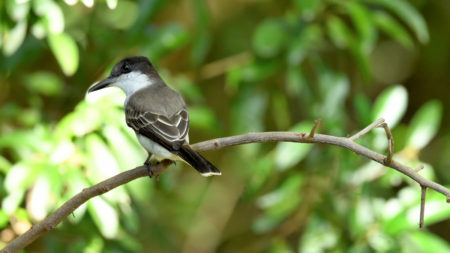
Our backyard – designed for birds
I started creating the birding area in 2014. It began after we extended the house and cleared the builders’ rubble in the “bush” left behind from the construction of the housing scheme called Long Mountain, on the outskirts of Kingston. The land behind the house is dry limestone forest, on the southern side of the Mona Dam, one of the reservoirs which serve the city’s water needs.
The terrain is steep, and the undisturbed, virgin forest is difficult to traverse.
We set up our bird station in 2015 with a water trough (plastic roller paint pan) and a flat open grassed area for broadcast feed (cracked corn) surrounded by the forest leaf litter and bush. Beyond the water station is a sliver of flat land approximately 50 feet from my observation position. Shielded by trees on three sides, this includes a gently sloping area, now covered in leaf litter. Caribbean Doves use this as a courtship area while White-chinned Thrushes and Ovenbirds use it as a hunting ground.
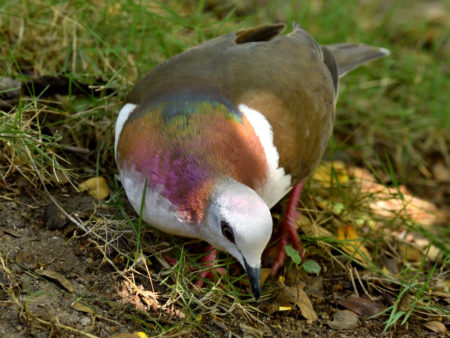
The first birds I observed were a group of Caribbean Doves. These beautiful birds walk on their crimson feet; the crunching of dead leaves underfoot was my introduction to them. They were shy, but eventually came in to feed accompanied by White-winged Doves, Zenaida Doves, and Common Ground Doves.
Gradually other birds followed as the doves became regular visitors and excellent watchmen.
The variety of migratory and local birds is extensive. In 2021, I took on the challenge to document the birds and enjoyed the time spent in the bush – stalking the birds that do not come in for water or feed but passed through the forest edge canopy.
The arrival of COVID changed everything
Just before Christmas 2021, COVID-19 came home to roost, in the form of a love letter from the Ministry of Health and Wellness, advising me that I was quarantined for fourteen days. What to do? My good friend and fellow BirdLife Jamaica member, Kahlil Francis, suggested I take the camera, capture the birds in the yard, and put them together as a record of the visiting birds. I’m glad I took him up on his suggestion.
I had already spent many hours watching and photographing birds here at home and at Hope Gardens, but now had to focus on the area around the water station some 30 feet away. My wife only cautioned that I did not stand or sit in a cold breeze. Some days I could hardly manage myself and the camera; on other days I was on task and on target. If you have endured COVID-19, I am sure you understand this ebb and flow of energies.
Most of my images were made between 3:00 pm and 5:30 pm, when the majority of smaller birds came in for water and a good bath.
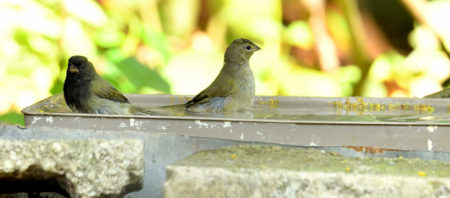
A flood of feathered visitors
There were warblers in abundance, besides Northern Parulas, American Redstarts, Bananaquits, White-chinned Thrush; these were the everyday stars of the bird station. Rarely, a Loggerhead Kingbird or better still, a Gray Catbird (an uncommon winter visitor) came to the birdbath. It was never dull. The only visitor that is really hard to photograph is the Jamaican Tody, which passes through very fast, flitting from perch to perch.
Pigeons and Doves scare all but the bravest birds away when they feed and fight, clapping wings with threatening vocalizations. At the watering station, the Bananaquits were fearless, refusing to leave while White-wings that dwarfed the Bananaquits drank their fill. Defiance fits the little bird well. It looked and acted angry. The doves left.
Similarly, one of the male Black-throated Blue Warblers would swoop in and throw water around, hissing and posturing at any bird rude enough to use the facility while he was bathing. No one told the Grassquits to be afraid of this posturing, and the defiance of this local resident was good to observe. The Grassquits just went on with their business, totally disregarding the warblers’ antics, their swagger and their hissing.
The highly strung…
The Loggerhead Kingbird and endemic White-chinned Thrush (Hopping Dick) receive the Award for Being Highly Strung. Loggerheads do not usually perch to drink; they swoop down, crash into the water and fly on, return, and repeat. The Loggerhead devotes a huge amount of time to carefully looking around and selecting the best launching point. The swoop is very fast and furious. The White-chinned Thrush is a terrestrial poser. It will come in, prance, pose, look around repeatedly and only when sure, will take a quick sip or two. Then it reverts to posing, prancing, and if you are lucky giving a piercing call.
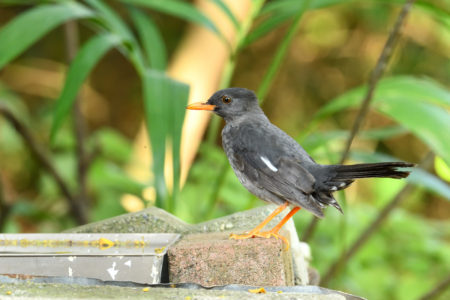
…and the show-offs
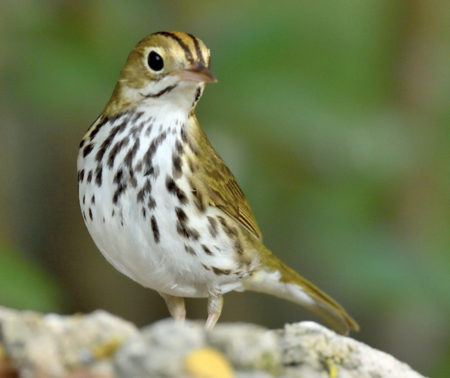
Our two Ovenbirds (local name: Betsy Kick-up), are ground-level birds too, strutting their stuff around the area once they feel comfortable and at home. Most days they announce their presence by belting out a call repeatedly tea-cher, tea-cher, tea-cher; it is very loud for such a tiny bird. They walk as though “large and in charge,” finding perches with a view and posing for the camera! With a shiny white, dappled chest held high, they run through the bird melee to take up grains of corn, and for the first time I watched as they went to the water to drink. Like the White-chinned Thrush, they were very alert and fast dippers while drinking, then off they proudly walk. It is wonderful to see one putting on a show to the other, raising its golden-brown crown bordered with black, and showing off its colours.
The bathing crowd
Then we come to the really dedicated bathers, with female American Redstarts in the vanguard. They start and end the bathing frenzy with all the other warblers and grassquits joining in. They bathe, fly off to preen, return, and repeat, often with the Black-faced Grassquits. It’s a jolly, competitive mob, each trying to best the last bather. Northern Parulas are the most energetic. Sometimes they come to a halt, apparently taking a count before another round of bathing.
The number of Yellow-shouldered Grassquits coming in to drink has increased. They are dainty drinkers that do not waste any time. In, drink, and gone. I have yet to see a male of this endemic species bathe. Black-faced Grassquits are next in line and their numbers are on the increase. Both male and female bathe with considerable energy.
The shy ones
Our winter visitors, the Black-and-White Warblers are very shy, whether drinking or bathing. A single click of my camera is sufficient to send them fleeing. As a photographer, I have to watch them carefully and take single pictures frame by frame, not in full drive mode.
To my surprise a Gray Catbird has returned for a second year. I observed and photographed one twice last year. This year, this uncommon winter visitor, a shy bird that is normally hard to spot, has appeared hopping from the bush into the water. Once there, it is unstoppable. It’s in at the deep end. Water is propelled vigorously everywhere. After taking a breather, it continues. It probably holds the record for taking a long bath at our bird station. Then it hops away; it never flies off. I think I have seen the bird only fly in the deep bush, as a fast-moving shadow.
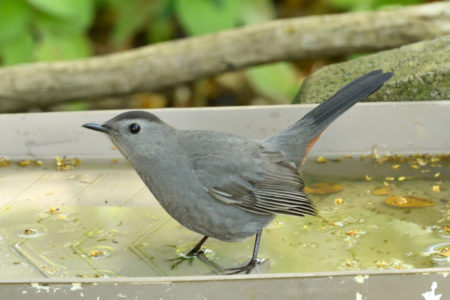
Tips for bird bath watching and photography
Here are my recommendations for backyard birding at the bird bath:
- Find a comfortable observation point; you may be there for two hours.
- Be still and make slow movements, whether you are using binoculars or a camera.
- A monopod for binoculars or camera eases the demand on the upper body.
- Be patient, observe until you learn how different birds behave.
- Place dead branches around the water station, as many birds like to scope out the surroundings before coming in. They can also perch and preen on the branches after bathing.
- Watch the trees around the area, as birds will move through them towards water. This gives you a heads-up that they are approaching.
- Change the water every day. It may sound daft, but as soon as the water is changed and the container is clean, the water sparkles – and yes, the birds move in.
- Be prepared to deal with predators! Cats and mongoose can be problems; the birds will give an alarm call. I keep a slingshot handy to discourage them. Mongoose will chase young birds into a tree and follow them up the tree – they can climb very fast. Cats tend to leap from cover and box birds out of the air; they too are fast movers.
Doves are the prey of choice for these marauders. Just keep that slingshot within reach! As with everything else, practice makes perfect. Soon you will no longer hit your own thumb…which is painful and then some!
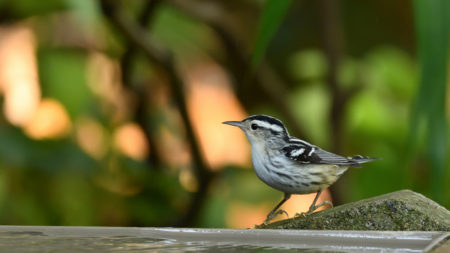
My COVID therapy – the joy of the bird bath
The birds helped me to forget COVID. I was so busy concentrating, observing and photographing local and visiting birds as they enjoyed the watering station. Should you have the opportunity to watch birds bathing, then go for it. Nothing beats watching the sheer joy of birds simply enjoying the moment, shaking dry, preening feathers, preparing for nighttime.
There are some benefits to quarantining with COVID, after all! I got to know my neighbourhood birds so much better!
Enjoy more of Stuart’s back-yard bird photos below, click on each image to enlarge and scroll through the gallery.


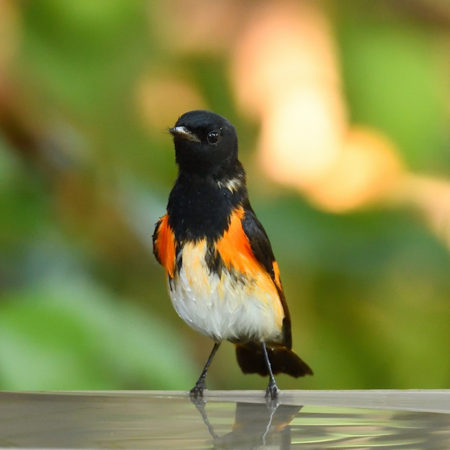
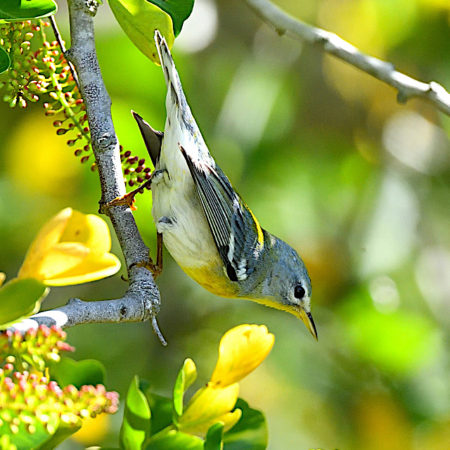
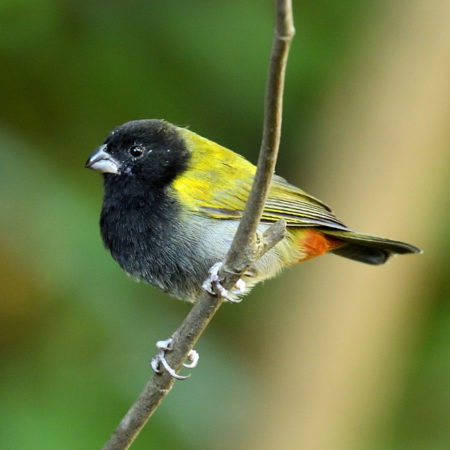


















Amazing article about coping with pandemic and potentially meeting new bird friends!
Stu, this is a beautiful documentary of Jamaican birds. It is so relaxing to sit and watch the birds at my bird feeder and bath. I hope this will encourage more Jamaicans to start bird watching. So much to learn from these small creatures.
Excellent article and good therapy to help you recover from covid and other issues. Will be making a bird bath in Portland.
This is beautiful.I have learnt a.lot from you to set up my own bird sanctuary.I have a bird bath and.gradually the nirds are coming to drink and bathe in it.
I do not know the names of the.birds but the.ones that came first are ground doves.Now your article has.given me inspiration to develop an interest.I am.in Tower Isle where there are.many fruit trees and much vegetation.
You can see the birds darting in and out of the ackee and apple trees.You compete with them to get any for yourself.Did you know that birds eat pomegranates’?
And June plums.
Many congratulations! What a wonderful document!
Thanks for this. My yard still has builders rubble and is quite bare but my my neighboring lots are empty and they don’t debush. I am going to try to at least set up a birdbath and see what happens. From Clermont Highgate St Mary
Thanks for your kind words, Barbara, we will pass them on to Stu, and yes, birding is so relaxing and stress-relieving! We do hope Jamaicans and many others will be inspired to take up birding!
Birding and spending time in nature is indeed good therapy – the best! Good luck on your bird bath in Portland and let us know what you are seeing!
Dear Beryl, thanks for your lovely comments – we will make sure that Stu sees them. Yes, many bird birds are fruit lovers . .. if you know what to plant, they will come! We have a nice eBook on our website about native plants for a bird-friendly yard: https://www.birdscaribbean.org/resources/#HeritagePlants And here is a webinar about the subject: https://youtu.be/IGdue-4cJ6E
Thanks for your positive feedback Betty, we appreciate this! Good luck with attracting birds nearby with a birdbath, and do let us know how it goes!
We agree, Kirk, we love this article by Stu and found it to be so inspiring!!!